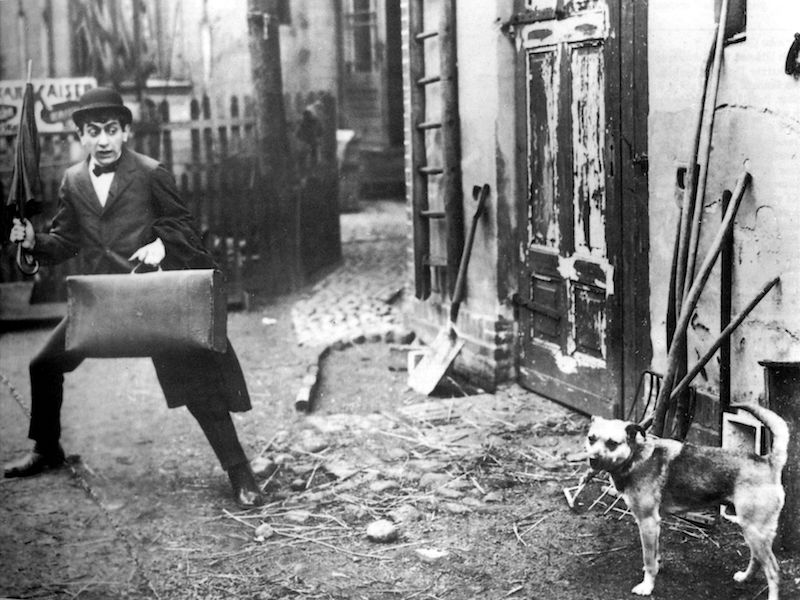DER STOLZ DER FIRMA
[The Pride of the Firm]
Carl Wilhelm (DE 1914)
Ernst Lubitsch’s father was a master tailor in Berlin; his son was hired as an apprentice in his shop with the intention that he would later take over the business. But Ernst Lubitsch wanted to be an actor. Many of the early comedies in which he appeared were not yet directed by him, but they reference his background. They take place in fashion houses, where clumsy but clever salesman Ernst Lubitsch wants to escape from the burdens of work, charms the female customers, and ultimately impresses his bosses with his impertinence and rascally attitude. The very names of his roles point to the Jewish character of the figure embodied by Lubitsch: Moritz Abramowsky, Siegmund Lachmann, Sally Pinkus, Sally Katz.
“It has often been said that people object to films in the Jewish milieu. That is a totally unbelievable point of view. In case such a film provokes disapproval, this is solely because of a presentation unsuitable for Jewish humor, and then the artist had better leave his hands off it, or because of the type of excessive exaggeration that compromises each and any form of artistic presentation and harms its effect. Jewish humor, wherever it may appear, is pleasant and artistic, and plays such a big role everywhere that it would be ridiculous to deprive cinema of it.” (Ernst Lubitsch, in conversation with Julius Urgiß, Der Kinematograph, 30.08.1916)
Der Stolz der Firma is a variation of sorts on the film Die Firma heiratet, which director Carl Wilhelm and scriptwriters Jacques Burg and Walter Turszinsky had made the previous year with Lubitsch in the lead. The film premiered on 30 July 1914, but was only released to German theatres in June 1915 due to the outbreak of war.
In the opening credits, Lubitsch is presented as the star of the film: “Ernst Lubitsch, Deutsches Theater Berlin, the actor in the title part.” The film blatantly advertises the film’s supporters in Reels 2 and 3: “All dresses are from the ateliers of the company Glaser & Goetz, Berlin. The hat models are from the house of Auguste Münzer, Berlin.” At the end of the film, which shows the ruthless advancement of the apprentice to general manager of a fashion firm (“Many have the calling … but only a few uncalled ones are chosen!”), a split-screen shows the transition of the main character quite plainly: Lubitsch “now and then,” the clumsy country apprentice in too-tight a suit, and the successful businessman with smart suit and moustache.
After the premiere for invited guests, Lichtbild-Bühne said on 1 August 1914: “Thus, in three acts and an epilogue (…), all that is original and characteristic, and makes those around Hausvogteiplatz so interesting, passed across the screen. Delightful intertitles give the real spice to the whole affair, and the amusing musical ideas of the conductor, Mr. Glücksmann, with great finesse and humor very cleverly underline the whole thing, in which (…) ‘flicker’ artists Marthe Kriwitz, Victor Arnold, and Albert Paulig group around Lubitsch to make things work with talent, good spirits, and taste. That it did has been proven by its success, since regardless of the danger of war, the fees of censorship, the dropping of prices, and lack of money, the laughter was carefree, cheerful, and without interruption.”
It is especially interesting today to see the depiction of Berlin’s fashion and tailoring district, which was centred around Hausvogteiplatz in the late 19th and early 20th century.
Stefan Droessler


regia/dir: Carl Wilhelm.
scen: Jacques Burg, Walter Turszinsky.
photog: Friedrich Weinmann.
cast: Ernst Lubitsch (Siegmund Lachmann), Martha Kriwitz (Lilly Maass), Victor Arnold (J. C. Berg), Albert Paulig (Charly Forst) , Alfred Kühne (Herr Hoffmann), Hugo Döblin.
prod: Paul Davidson, Projektions-AG “Union” [PAGU], Berlin.
uscita/rel: 30.07.1914 (UT Friedrichstraße, Berlin).
copia/copy: 35mm, 1258 m., 68′ (16 fps); did./titles: GER.
fonte/source: DFF – Deutsches Filminstitut & Filmmuseum, Frankfurt; Friedrich-Wilhelm-Murnau-Stiftung, Wiesbaden.




